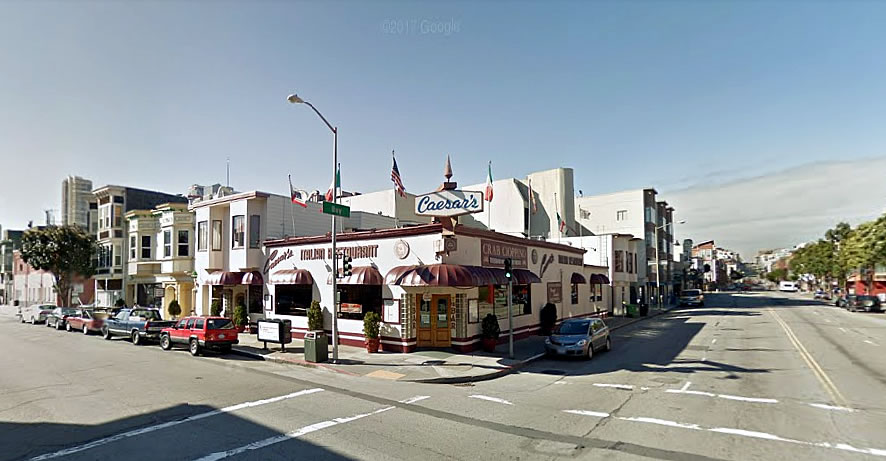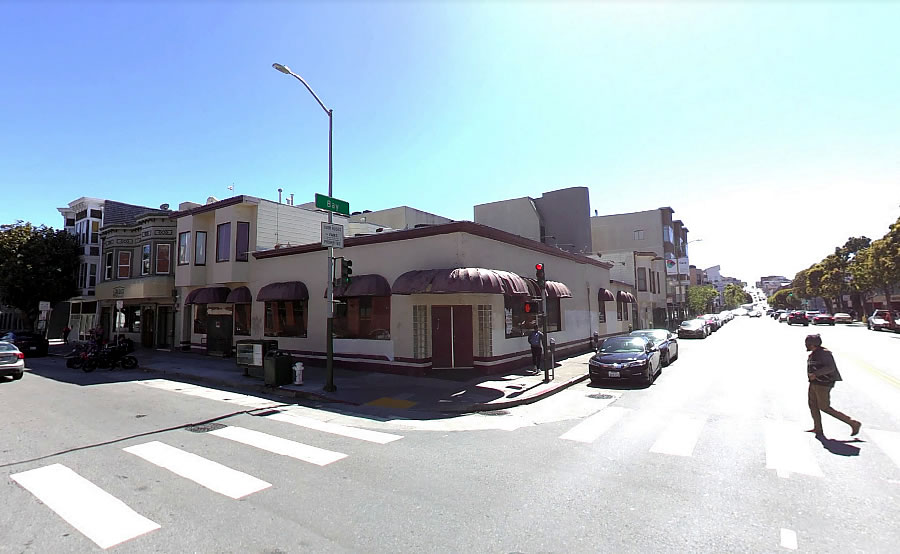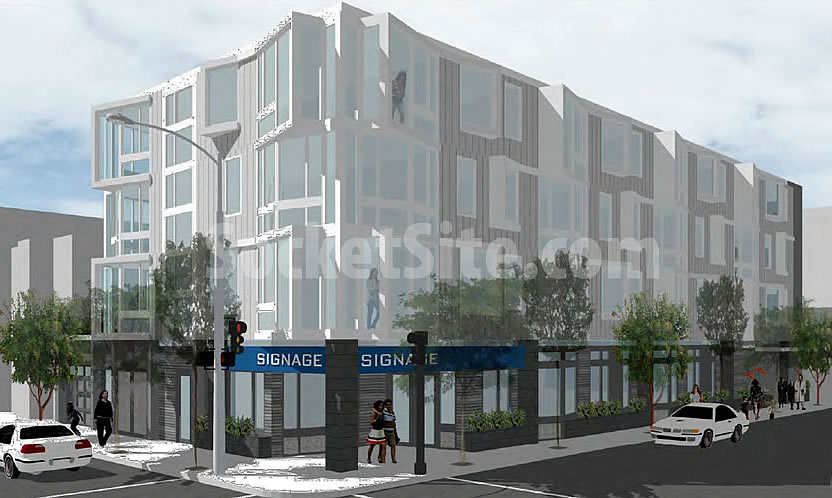Shuttered in 2012, plans to raze and redevelop the former Caesar’s Restaurant parcel on the southwest corner of Bay and Powell were approved at the end of 2015 with the project team positioning to break ground on the 4-story, 17-unit building with a ground floor commercial space the next year.
While a demolition permit was requested and approved in mid-2016, it was subsequently cancelled and the shuttered, one-story restaurant still stands.
And having been redrawn to incorporate ground floor parking for 6 cars, versus an underground garage with 17 spaces as originally envisioned, the approved plans and 2293 Powell Street parcel are officially on the market, and have been for a couple of months, with a $5.5 million price tag.



Another abandoned entitlement. That brings the number of units in abandoned projects to about 2,223. The financials are not there to move forward with many of the currently entitled projects. The sell rather than build scenario should continue next year. 5M seems to be on indefinite hold and may never get built. Parcel F is another project that is probably dicey for its investors. Especially given the outrageous amount they paid for the site. It wouldn’t be a surprise if the project is scaled back. Perhaps drop the condos and only go forward with the hotel and office component.
I’m not sure we should be super concerned about Parcel F, esp with Salesforce interest. 5M always seemed like a dodgy spec project to me. I’m more bummed about all of the smaller to medium sized projects that are stalling as a result of slow-moving process and rising costs.
Indeed the rising construction costs – along with the plateauing of condo appreciation – make many of these projects unfeasible now. The smaller to medium sized one are more likely to be abadonned but even large ones such as One Oak (300 units) are no longer feasible. In terms of slow the moving process, these are entitled projects and could have broken ground already – the City planning bureaucracy, bad as it is, is not slowing these developments.
Unfortunately, I no longer feel “the process” is exclusively the fault of inefficient city methods, but rather the outspoken neighborhood groups and so-called concerned citizens. It’s become a bit of a cliché but the NIMBY thing is really killing progress and effectiveness in this city.
Right. But here’s the thing. The city methods you allude to, which is the Planning Department, actively seeks to pass the buck. It is de facto policy to actively seek to kick everything back to the various neighborhood groups.
Yeah. London Breed came in the door talking about tackling homelessness and about addressing the ridiculous ad hoc bureaucracy that has come to typify the Planning Department. Now is the time to step up. Who are these residential design team people who get to tell you what to do? and why can’t you schedule a meeting with them? why is the default modus operandi to shift all things back to neighborhood input and paralysis by analysis? At some point in time, seemingly, a back channel memo went out and the gist of it was “slow gentrification down.” Well, enough of that. Nothing is getting done and it is stupid.
Another couple things regarding the cost of bigger projects and smaller projects both, are these factors. The fluctuating markets for raw materials under the Trump administration has not been a helpful turn of events. Also, the labor shortage caused by wildfires has allowed for local carpenters to charge premiums. Seemingly the former will be sorted out eventually. This new north american trade pact that’s supposed to be put into place could help. The fires though probably will continue. And builders and carpenters from exurb type areas will not need to travel to the city for work.
The delays in entitlements are most of the time what has caused the projects to go on hold in the first place. A project envisioned and penciling in 2014, not entitled until 2017 because some neighbor’s delicate sensibilities need to be bought off, may just not work anymore. That you can say the multi-layered bureaucracy that is SF planning has clean hands in this regard defies logic.
“Unable to lure top biotech talent to Seattle, [Seattle Genetics] is opening a Bay Area office.”
Item in today’s SF Business Times.
Here’s a random thought. Are the new high construction costs the new “normal”? People rarely end up taking pay-cuts in their career, so while some workers will take a 10-20% cut just to have a job, is that really going to move the needle to make some of these projects pencil out?
Workers can go to the Paradise area or Santa Rosa to get work. And high construction costs in SF due to materials and labor also are happening in Seattle and Las Vegas. Yet those cities are seeing a slew of projects under construction and few if any projects being abandoned. One reason is the anticipated appreciation in housing prices in those two markets over the medium term. Population is surging and demand will only go up over the next decade in places like LV and Seattle while SF is not going to see a significant increase in demand. Hence the rising construction costs are a project killer in SF.
That was a complete mess of a post. LV and Seattle are not at all alike, one. The idea that developers base calculations on appreciation is also wrong. You always start with your foregone conclusion and then try to cobble something together from that standpoint, Dave. Do you not realize everyone sees that?
Developers – their financial backers – do indeed base their calculations in part on the final product and what it will sell for. They generally are conservative in making that projection. They are looking for a reasonable ROI that is relatively risk free. This is why some entitlements like the one in the Tenderloin that the developer paid an exorbitant price for are so risky. That developer was banking on a large appreciation in Tenderloin new construction condo prices – why else did they pay a price per door that was close to what developers were paying in very upscale areas of SF?
Of course they base their calculations on the final product and what it will sell for. That is not what you said.
What he said was a complete non-sequitur:
(1) “generally conservative”, but
(2) “paid an exorbitant price” because
(3) “were banking on large appreciation”
Unless of course the claim is that they’re atypical…but if that’s the case, why use it as an example of a general trend you’re trying to validate.
Don’t bother. Dave starts with whatever the conclusion is that he wants (SF has hit population historic population high and if anything will decrease in population, jobs will shift to the East Bay and they’ll get all the Class A office towers, Seattle will be the bigger city in 10 years while SF shrinks, OneOak and 555 Howard will be downsized to eight story buildings, whatever) and goes from there. It’s insane to engage with the fan fiction.
“Workers can go to the Paradise area or Santa Rosa to get work….”
Not only that but builders can have a higher quality of living in those counties due to the lower costs of housing. Anecdotally many of the construction workers I know abhor working in SF due to gnarly commutes and parking headaches.
Doing construction in SF is often insanely difficult and it’s hard to get good labor to put up with the conditions. Steep slopes, crowded with older buildings in poor shape, litigious neighbors, corrupt city inspectors…
The flip side is the projects can be brilliant. Everyone who ever had a grandfather work on the Golden Gate Bridge or the Transamerica pyramid can tell you their story. No one talks about building tract houses in Santa Rosa.
So long as the present value of the development project exceeds the present value of renting the space as a restaurant, this will get built. I can’t see the site being worth anything close to $5M as a restaurant…
This building is such an eyesore. I want it gone everyday when I have to walk by it to and from work.
UPDATE: Bigger Plans for Shuttered North Beach Site